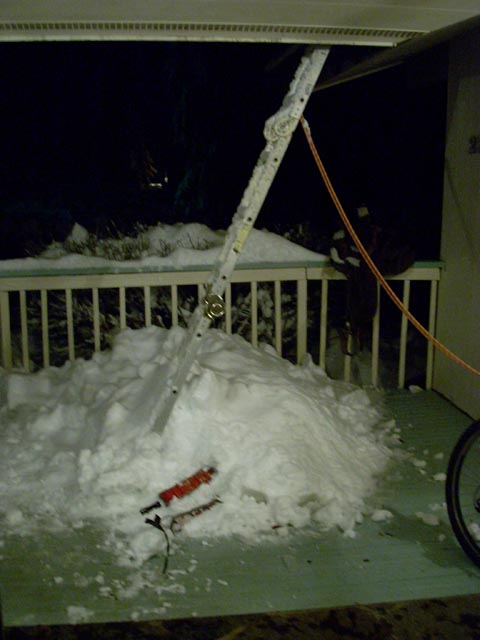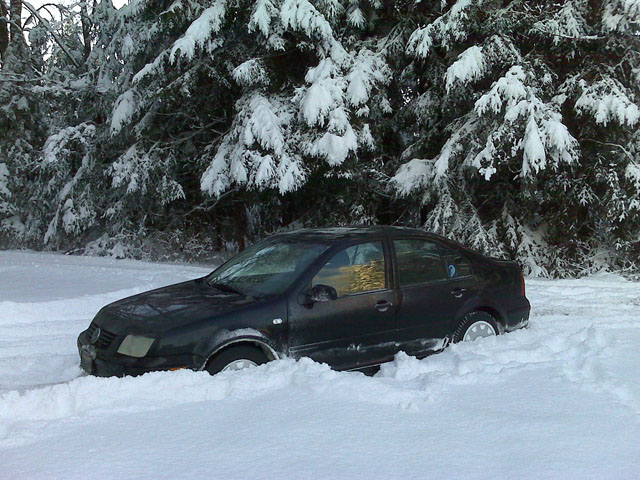
I had to get up on the roof today and shovel off some of the snow. We’ve accumulated over 2 feet of the stuff over the past 5 days and it is still coming down. This region is not really adapted to that level of snowfall. Our roof has taken 28 years of rain and a bit of snow, but I figured it would be best to lighten the load before more comes down. The forecast has this going on for a while, so better to minimize chances of problems, right? I can recall the big blizzard of 1995 when I was awakened in the night by the sound of our roof groaning under the weight of about the same amount of snow. The precipitation turned to rain and suddenly that mass of fluffy white stuff turned into a leaden mass, threatening to collapse our house. I climbed up on the roof and shoveled like a madman that night. I filled the entire space between my Ballard area house and the garage with snow. I was able to walk from one to the other! While I was shoveling the garage roof my neighbor’s garage collapsed.
While I’m sure our house is better constructed than my old one in Seattle, it is better safe than sorry.
In my adventurous youth I was an alpinist. I still have all my equipment so I pulled some of it out and suited up for the task. My old Choinard harness doesn’t fit anymore… I’m no longer the trim 195 lb kid anymore… I’m a pear-shaped middle aged man. 🙁 The “Static Point Utility Belt” I had my friend Jeff Wright custom-build for me 20 years ago did barely fit, so that became my harness. In the old days these sorts of things were called “swami-belts” … but mine was built specifically for climbing a wonderful big slab here in the Cascades named “Static Point” which was almost a private playground of mine (and a few friends) back in the Mid-to-late 80s. It is all low-angle friction climbing so a shoulder-based rack was impractical, hence my “utility belt”… this was before harnesses started incorporating rack loops.
I dug out my old mountaineering boots and crampons, a snow shovel, and a rope. I had not worn my boots since I summited Mt. Rainier a long, long time ago. I used to do crazy things like climbing in winter… snow, ice, the works. (One of these days I’ll dig out my kodachromes and write up some climbing stories.) I suited up, tossed the rope (in a bag) and the shovel up onto the roof, and started climbing up the ladder. Just about at the top my left crampon seemed to come off, so I came back down. Upon reaching the ground I noted that the crampon hadn’t come off, but my boot sole did!

These are an old pair of Koflach mountaineering boots, IIRC the second generation of plastic boots. They were hailed as being a technological breakthrough that would last forever compared to leather boots. While they certainly were warmer and drier than leather, my Asolo “snowpine” leather telemark boots from the same era certainly lasted longer! I wonder if REI would take these back as defective? 😉

I put on different boots… a tired old pair of Dynafit TourLite ski mountaineering boots, and ascended the ladder once again. I retrieved the rope and wrapped it around the enormous natural bollard that is our chimney, attached myself to it via a set of ancient Jumar acsenders given to me by Ray Smutek. I made a slow circumnavigation of the roof, shoveling off a thick layer of snow all along the edges. The idea is to lighten the load, and hasten melting into the gutters when warmth returns. I was amazed how quickly my brain recalled rope & crampon protocol. The rope wasn’t going to save me if I went off, but it did enable me to perform a classic tension traverse and let me maintain balance as I walked along the edge of the roofline by giving me something to lean away from. This was critical in the moments when large, heavy shovelfuls of snow would dislodge and fall away. The little ‘hip check” maneuver to tip it over the edge would likely send me over the edge after the snow had I not had a force to counter against in another direction.
About halfway through the job I ascended up to the wide flat chimney top to sit down shed a layer of clothing and cool off. I had also forgotten how hot you can get while laboring in cold weather! As I sat there I slapped myself for not bringing a camera up there to document a bit of this for you all. Oh well. One thing I noted while up there… a triggered memory really… was the full-body tension that comes with a certain sound. The trees would occasionally lose their accumulated snow and the “whump – whoosh – whump” sound they make while doing it is exactly the sound a slope makes when it avalanches. To anyone who has travelled in high country in winter, on skis or on foot, knows… and fears, that sound. I was safe however… merely sitting upon the summit or ridges of Mt. Chez Goolsbee.
After I completed the full-roof-circumcision, I went around the newly rebuilt deck and shoveled off the huge piles I had dumped all over it. Man that snow was heavy! Sue even pitched in on this effort after I wore myself out. I was thinking how nice it would be to have the boys here, as they could have done this WHILE I was doing the roof.
As I finished the task I noted water flowing on the driveway and went down to investigate. Sure enough a pipe had burst in the garage. Dammit. This is that garden hose faucet out at the far end of the garage… the one that is subject to freezing. I’d been running a candle under the faucet itself for days now to keep it from freezing. Why had it burst? I shut off the water to the house and undid the faucet from the wall. No obvious issue there, but something was wrong. Time to break into the drywall! Went through it with a hatchet. I decided to just plug that pipe in the wall. I grabbed my plumbing gear from the barn and tried to improvise a plug. I thought I had it sorted out and turned the water back on. A torrent came streaming out of the wall, from higher up than what I had excavated. Turn the water back off and remove the entire bit of (wet) drywall to find a VERY small burst area in the copper pipe about two feet up from the 90° bend where the faucet goes out the wall. My candle had kept the faucet from freezing but could not keep the pipe inside the wall warm. Oh well. It is now after dark and too risky to go into town to try to find the gear to fix this. Thankfully in Sue’s paranoia we’d filled the bathtubs with water to have in case of emergency to run the toilets. We have plenty of drinking water saved in the downstairs fridge too. We’ll be fine… so long as the power stays on.
We ate a dinner of warmed up leftovers and a nice bottle of Tempranillo. Afterwards I went into my home office to write this up, and… the power went out! This was about 7 pm or so. Nothing to do but crawl into bed. Amazing how absolutely dark it is without power.
Around 3 am the power came back on, much to my relief. In the time between 7 pm and now (~4 am) it has snowed another foot!
Thankfully I left the ladder and rope set up should I need to return to the roof for more excavation.













